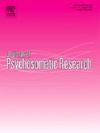主要医学疾病患者躯体症状障碍的风险:基于人群的汉堡市健康研究的横断面结果
IF 3.5
2区 医学
Q2 PSYCHIATRY
引用次数: 0
摘要
背景:躯体症状障碍(SSD)的特征是与躯体症状相关的过多的思想、情绪和行为,而不考虑其病因。通过自我报告问卷评估的SSD频率估计范围在6.7%(一般人群)和53%(特殊环境)之间。本研究旨在利用基于人群的汉堡市健康研究的横断面数据,研究重度医学疾病(MMD)患者发生SSD风险的频率及其相关因素。方法:采用躯体症状量表-8、躯体症状障碍- b标准量表-12和症状持续性一项对SSD风险进行评估。在生物、心理、社会因素方面对有SSD风险和无SSD风险的人进行比较。通过分层多元logistic回归分析确定与SSD风险相关的因素。结果:N = 1944人(平均年龄64.8±8岁,女性43.8%)报告至少一次烟雾病。其中,6.8% [95%,CI 5.6-7.9%]存在SSD风险,并报告较高的医疗保健利用率和较低的健康相关生活质量。Logistic回归发现年龄较大(p= 0.032),受教育程度较低(p= 0.002),躯体合并症数量较多(p= 0.45)。结论:在烟雾病患者中观察到的SSD风险频率并不表明该样本中存在过度的症状负担。然而,那些有风险的人经历了严重的心理社会负担和增加的医疗保健利用,突出了一个易患SSD的弱势亚群体。本文章由计算机程序翻译,如有差异,请以英文原文为准。
Risk of somatic symptom disorder in people with major medical disorders: Cross-sectional results from the population-based Hamburg City Health Study
Background
Somatic Symptom Disorder (SSD) is characterized by excessive thoughts, emotions, and behaviors related to physical symptoms irrespective of their etiology. Estimates of SSD frequency assessed via self-report questionnaires range between 6.7% (general population) and 53% (specialized setting). This study aims to examine the frequency of risk of SSD and associated factors in people with Major Medical Disorders (MMD) using cross-sectional data from the population-based Hamburg City Health Study.
Methods
Risk of SSD was operationalized using the Somatic Symptom Scale-8, the Somatic Symptom Disorder-B Criteria Scale-12, and one item on symptom persistence. People at risk of SSD and not at risk were compared regarding biopsychosocial factors. Factors associated with risk of SSD were identified by hierarchical multiple logistic regression analysis.
Results
N = 1944 people (mean age 64.8 ± 8 years, 43.8% female) reported at least one MMD. Of those, 6.8% [95%, CI 5.6–7.9%] were at risk of SSD and reported greater healthcare utilization and lower health-related quality of life. Logistic regression identified higher age (p=.032), lower education (p=.002), number of somatic comorbidities (p<.001), and elevated neuroticism (p<.001) and depression (p<.001) scores as factors associated with risk of SSD, with an explained variance of Nagelkerke R2=0.45.
Conclusion
The observed frequency of risk of SSD in people with MMD does not point towards an excessive symptom burden in this sample. However, those at risk experience significant psychosocial burdens and increased healthcare utilization, highlighting a vulnerable subgroup prone to SSD.
求助全文
通过发布文献求助,成功后即可免费获取论文全文。
去求助
来源期刊
CiteScore
7.40
自引率
6.40%
发文量
314
审稿时长
6.2 weeks
期刊介绍:
The Journal of Psychosomatic Research is a multidisciplinary research journal covering all aspects of the relationships between psychology and medicine. The scope is broad and ranges from basic human biological and psychological research to evaluations of treatment and services. Papers will normally be concerned with illness or patients rather than studies of healthy populations. Studies concerning special populations, such as the elderly and children and adolescents, are welcome. In addition to peer-reviewed original papers, the journal publishes editorials, reviews, and other papers related to the journal''s aims.

 求助内容:
求助内容: 应助结果提醒方式:
应助结果提醒方式:


